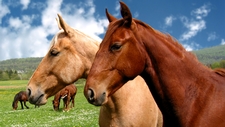What is a Trait?

TEKS Objective
The student is expected to explore that some characteristics of organisms are inherited such as the number of limbs on an animal or flower color and recognize that some behaviors are learned in response to living in a certain environment such as animals using tools to get food.
Essential Understanding
The student knows that organisms undergo similar life processes and have structures that help them survive within their environments.
Science Background
What Is a Trait? Learn Genetics: University of Utah (website) - Learn about different kinds of physical and behavioral traits, and how they are determined.
What Is a Trait?
Learn Genetics, University of Utah, learn.genetics.utah.edu
The Genetics of Inherited Traits: K8 Science (website) - Dr. Ron McNeel explains how characteristics are passed from parents to their offspring.
The Genetics of Inherited Traits
K8 Science, www.k8science.org
Signature Lesson
Generations of Traits: Genetic Science Learning Center (PDF) - Hands-on activity during which students track and record the passage of colored “traits” through three generations of gingerbread “people,” thereby learning that some characteristics are inherited from parents, and that siblings may or may not receive the same traits from their parents.
Generations of Traits
Genetic Science Learning Center, University of Utah, teach.genetics.utah.edu
- Supporting Lessons
- Extensions
- Assessment Ideas
- Literature Connections
- Related
TEKS - Additional Resources
Supporting Lessons
Twins, Comparing Behaviors… Instinct v. Learned Behavior: Utah Educational Network (website) - Students observe themselves and their family members to understand the difference between learned and inherited/instinctive behaviors. Includes extensions and assessment.
Twins, Comparing Behaviors… Instinct v. Learned Behavior
Utah Educational Network, www.uen.org
Classification Scheme: Science NetLinks (website) - Students identify and use various traits to group or classify different types of animals. Includes downloadable master of animal cards.
Classification Scheme
Science NetLinks, www.sciencenetlinks.com
My Traits Please: Regent University (PDF) - Students conduct a class inventory of simple inherited traits, such as tongue rolling, and explore frequencies within the class population.
Elaboration Lessons and Extensions
Animal Adaptation Teacher Guide: The Zoo Society (PDF) - This comprehensive unit, designed to support a self-guided tour of the Milwaukee County Zoo, contains a wealth of information and activities on animal adaptations that can be used in any classroom.
Animal Adaptation Teacher Guide
The Zoo Society, www.zoosociety.org
Animal Adaptations: SeaWorld/Busch Gardens (PDF) - In this series of lessons, students investigate and determine the function of various animal adaptations (the design of different bird beaks and feet, animal camouflage).
Assessment Ideas
After completing the Signature Lesson, have students write a paragraph describing the most and least common traits among students in the class.
Literature Connections
You and Your Genes. Johnson, Rebecca (ISBN-13: 978-0792288664)
Albino Animals. Milner-Halls, Kelly (ISBN-13: 978-1581960129)
Traits and Attributes (Let’s Relate to Genetics). Hyde, Natalie (ISBN-13: 978-0778749660)
Additional Resources
Variation, Deadly 60: BBC KS2 Bitesize (website) - In this interactive activity, students sort dangerous plants and animals into groups, based on their characteristics.
TEKS Navigation
Grade 3
Need Assistance?
If you need help or have a question please use the links below to help resolve your problem.

Comments